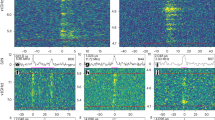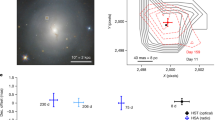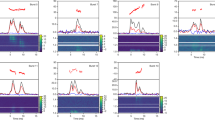Abstract
DURING the 1962 opposition of Jupiter we made some exploratory observations with a long baseline interferometer in an attempt to obtain information on the sizes and distribution of the decametric burst sources. The observations were made at 19.7 Mc/s with a north–south baseline of 32.3 km, equivalent to 1940 λ at tho declination of the planet. They have shown that successful interferometry is possible at these large distances in spite of complications due to ionospheric irregularities. The angular diameter of a burst source was found to be less than a third of the planet's diameter, and all bursts contributing to a noise storm originated in a single area less than a half of the size of the planet's disk.
This is a preview of subscription content, access via your institution
Access options
Subscribe to this journal
Receive 51 print issues and online access
$199.00 per year
only $3.90 per issue
Buy this article
- Purchase on Springer Link
- Instant access to full article PDF
Prices may be subject to local taxes which are calculated during checkout
Similar content being viewed by others
Author information
Authors and Affiliations
Rights and permissions
About this article
Cite this article
SLEE, O., HIGGINS, C. Long Baseline Interferemetry of Jovian Decametric Radio Bursts. Nature 197, 781–783 (1963). https://doi.org/10.1038/197781b0
Issue Date:
DOI: https://doi.org/10.1038/197781b0
Comments
By submitting a comment you agree to abide by our Terms and Community Guidelines. If you find something abusive or that does not comply with our terms or guidelines please flag it as inappropriate.



